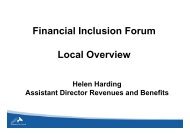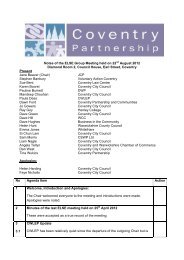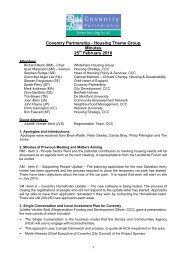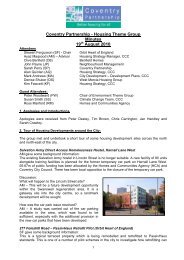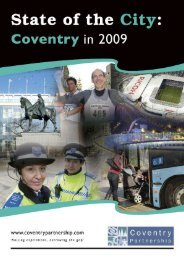Sustainable Community Strategy - Coventry Partnership
Sustainable Community Strategy - Coventry Partnership
Sustainable Community Strategy - Coventry Partnership
You also want an ePaper? Increase the reach of your titles
YUMPU automatically turns print PDFs into web optimized ePapers that Google loves.
• Carers<br />
• Ex-offenders<br />
• Homeless people<br />
• Looked-after children and young people (children<br />
and young people in the care of social services)<br />
• Older people experiencing isolation and poverty<br />
• People experiencing mental ill-health<br />
• People from the most disadvantaged black and<br />
minority ethnic groups<br />
• People with physical or sensory impairment<br />
• People with learning disabilities<br />
• Refugees and asylum seekers<br />
• Teenage parents and their children<br />
• Women and children experiencing domestic<br />
violence<br />
• Young people not in education, employment or<br />
training<br />
<strong>Community</strong> Cohesion<br />
2.23 For a city of its size and diversity, <strong>Coventry</strong> is<br />
comparatively well-integrated. Recent government<br />
research on segregation in cities shows that<br />
segregation between White and other ethnic<br />
communities in <strong>Coventry</strong> is low, particularly for a city<br />
with a high level of ethnic diversity, with an index of<br />
0.4 compared to 0.72 for Blackburn and 0.58 for<br />
Birmingham. Similar comparative data shows that,<br />
whilst there is a higher concentration of Black and<br />
Asian communities in <strong>Coventry</strong>'s deprived areas,<br />
this is relatively low in comparison to many similar<br />
cities in England.<br />
2.24 This relatively high level of integration may be<br />
reflected in the high perception levels of community<br />
cohesion recorded by <strong>Coventry</strong> <strong>Partnership</strong>'s annual<br />
household survey in 2006 where 93% of<br />
respondents agreed that people from different<br />
backgrounds get on well together. This figure has<br />
risen from 90% in 2004. The percentage of<br />
respondents who agreed that residents respect<br />
differences between people from different<br />
backgrounds has also risen from 91% in 2004 to<br />
94% in 2006.<br />
2.25 Like other areas of the UK, <strong>Coventry</strong> has<br />
recently been experiencing a higher level of<br />
migration from within the European Union, with a<br />
higher level of “population churn” with people<br />
moving into the city for short periods of time. This<br />
short-term movement is difficult to measure using<br />
traditional demographic statistical data and like<br />
many cities, <strong>Coventry</strong> is undertaking further<br />
research to better understand the impact that<br />
population churn is having upon the city and the<br />
services provided.<br />
3. Themes of the strategy<br />
3.1 A number of key themes have been developed<br />
as the basis for this strategy. All these themes are<br />
linked and it is essential to plan across the themes<br />
to ensure that our ambitions for <strong>Coventry</strong> are met.<br />
The long term outcomes and short term priorities<br />
which we are aiming for within each theme are<br />
included in section two of this document.<br />
The eight key themes are:<br />
• Economy, learning, skills and employment<br />
• Health, well-being and independence<br />
• <strong>Community</strong> safety<br />
• Cleaner, greener streets and open spaces<br />
• Children and young people<br />
• Housing<br />
• Transport<br />
• Culture, sport and physical activity.<br />
3.2 Two underpinning themes are critical to the<br />
success of the <strong>Sustainable</strong> <strong>Community</strong> <strong>Strategy</strong> and<br />
these addressed by all the other themes:<br />
• Equality of opportunity and involved, cohesive<br />
communities and neighbourhoods<br />
• Making a positive environmental<br />
contribution and tackling climate change<br />
3.3 Each of the themes will address the issues that<br />
face different communities and groups within the<br />
city. For example, issues specifically affecting older<br />
people such as the needs of older workers, specific<br />
health care and community services for older people<br />
and the special transport needs of older people will<br />
be addressed under the appropriate strategic<br />
theme. The only exception to this is for children and<br />
younger people. Issues affecting children and young<br />
people are addressed under the appropriate theme<br />
e.g. children's obesity is under the health, wellbeing<br />
and independence theme but there are some issues<br />
that relate to children and young people as a group<br />
that do not fit under the other themes, educational<br />
attainment for example, which will be addressed<br />
through the specific children and young people<br />
theme.<br />
3.4 The strategy sets out for each theme the<br />
explanation of why it is important and what needs to<br />
be tackled; the long term outcomes and short term<br />
priorities: how success can be measured; what key<br />
strategies and local organisations and communities<br />
need to do to address them; along with identifying<br />
the issues that need to be addressed to both meet<br />
the opportunities and challenges of future growth<br />
and also to ensure that the underpinning themes of<br />
Equalities and Cohesion and Climate Change are<br />
addressed. This is set out in section 2.<br />
3.5 The <strong>Coventry</strong> <strong>Partnership</strong> is seeking views and<br />
advice from people and organisations in <strong>Coventry</strong><br />
about how they think they can contribute to the<br />
further development of the <strong>Sustainable</strong> <strong>Community</strong><br />
<strong>Strategy</strong> so that we can make <strong>Coventry</strong> a place<br />
where people choose to live, work, learn and to do<br />
business and ensure that future growth is used to<br />
transform the city and benefit local people by<br />
improving quality of life, raising aspirations and<br />
narrowing the gap in the city.<br />
9




